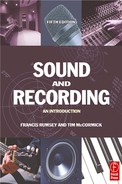Preface to the Second Edition
One of the greatest dangers in writing a book at an introductory level is to sacrifice technical accuracy for the sake of simplicity. In writing Sound and Recording: An Introduction we have gone to great lengths not to fall into this trap, and have produced a comprehensive introduction to the field of audio, intended principally for the newcomer to the subject, which is both easy to understand and technically precise. We have written the book that we would have valued when we first entered the industry, and as such it represents a readable reference, packed with information. Many books stop after a vague overview, just when the reader wants some clear facts about a subject, or perhaps assume too much knowledge on the reader’s behalf. Books by contributed authors often suffer from a lack of consistency in style, coverage and technical level. Furthermore, there is a tendency for books on audio to be either too technical for the beginner or, alternatively, subjectively biased towards specific products or operations. There are also quite a number of American books on sound recording which, although good, tend to ignore European trends and practices. We hope that we have steered a balanced course between these extremes, and have deliberately avoided any attempt to dictate operational practice.
Sound and Recording: An Introduction is definitely biased towards an understanding of ‘how it works’, as opposed to ‘how to work it’, although technology is never discussed in an abstract manner but related to operational reality. Although we have included a basic introduction to acoustics and the nature of sound perception, this is not a book on acoustics or musical acoustics (there are plenty of those around). It is concerned with the principles of audio recording and reproduction, and has a distinct bias towards the professional rather than the consumer end of the market. The coverage of subject matter is broad, including chapters on digital audio, timecode synchronisation and MIDI, amongst other more conventional subjects, and there is comprehensive coverage of commonly misunderstood subjects such as the decibel, balanced lines, reference levels and metering systems.
This second edition of the book has been published only two years after the first, and the subject matter has not changed significantly enough in the interim to warrant major modifications to the existing chapters. The key difference between the second and first editions is the addition of a long chapter on stereo recording and reproduction. This important topic is covered in considerable detail, including historical developments, principles of stereo reproduction, surround sound and stereo microphone techniques. Virtually every recording or broadcast happening today is made in stereo, and although surround sound has had a number of notable ‘flops’ in the past it is likely to become considerably more important in the next ten years. Stereo and surround sound are used extensively in film, video and television production, and any new audio engineer should be familiar with the principles.
Since this is an introductory book, it will be of greatest value to the student of sound recording or music technology, and to the person starting out on a career in sound engineering or broadcasting. The technical level has deliberately been kept reasonably low for this reason, and those who find this frustrating probably do not need the book! Nonetheless, it is often valuable for the seasoned audio engineer to go back to basics. Further reading suggestions have been made in order that the reader may go on to a more in-depth coverage of the fields introduced here, and some of the references are considerably more technical than this book. Students will find these suggestions valuable when planning a course of study.
